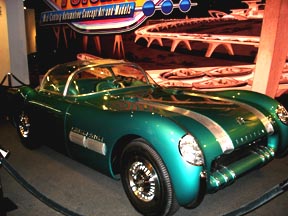Automotive Glamour
 Speaking of cars, I'm a week late linking to Phil Patton's fascinating NYT article on mid-century automotive illustration, examples of which are currently featured in a Detroit museum exhibit. These illustrations demonstrate that glamour doesn't depend on a particular style or a Hollywood context. These illustrations don't look at all like Art Deco artifacts or black-and-white studio stills, yet they create a similar effect--an emotional, imaginative process in which the audience projects itself into an idealized world. From Phil's article:
Speaking of cars, I'm a week late linking to Phil Patton's fascinating NYT article on mid-century automotive illustration, examples of which are currently featured in a Detroit museum exhibit. These illustrations demonstrate that glamour doesn't depend on a particular style or a Hollywood context. These illustrations don't look at all like Art Deco artifacts or black-and-white studio stills, yet they create a similar effect--an emotional, imaginative process in which the audience projects itself into an idealized world. From Phil's article:
Curators of the Detroit show are Jared Rosenbaum and Rachel Mackow of the Palace of Culture, an online "museum" of futuristic design, and Mark Patrick of the Detroit Library. They reached into a rediscovered cache of images by Arthur Radebaugh, an advertising illustrator best known for dreaming up and painting fantastic vehicles — streamlined flying buses, hovering monorails and other wonders of the future — in advertisements for Bohn Aluminum & Brass. In the 1930's, Radebaugh turned out gleaming images of production-line Dodges and Chryslers set against Buck Rogers backgrounds.
Many paintings in the show come from the collection of Jim Secreto, a photographer in Clarkston, Mich. Mr. Secreto found the images while working in the files of Detroit advertising agencies. "I fell in love with these illustrations for their romantic quality," he said. "They project an ideal lifestyle and fantasy that a lot of thought and effort went into creating."
Mr. Secreto said that his profession, photography, ended that of the auto illustrators. But it took a long time; photography gradually replaced illustration in most print advertising during the 1950's because it was less expensive and more versatile.
In auto advertisements, though, illustration dominated through the 1970's because painters could render effects that photographers could not. Before digital image manipulation existed, painters did a better job of romanticizing the cars, elongating and widening them, emphasizing highlights and shadows to bring out sculptural qualities....
Such manipulation was common. In some cases, the show's curators said, skilled specialists took photos of cars, sliced them up and separated the pieces ever so slightly to produce an elongated image for painters.
The effect of this style was to lend a touch of fantasy and magic to the images, making them touchstones of their era. A 1960 image of a Ford Galaxie cruising through downtown Detroit, by Ross Cousins and John Killmaster — they were among the most respected advertising illustrators — captures a bright morning scene, offering a broadly optimistic vision of life in America.
In his new book, Culture and Consumption II, Grant McCracken has a fascinating essay called "When Cars Could Fly," documenting the connection between jet age imagery, automotive styling, and mid-century metaphors of personal ambition.
 Last summer, Steve and I saw plenty of evidence for Grant's thesis at the Petersen Automotive Museum's Driving Through Futures Past, an exhibit that included both illustrations like the one above and a few prototypes like this Bonneville Special.
Last summer, Steve and I saw plenty of evidence for Grant's thesis at the Petersen Automotive Museum's Driving Through Futures Past, an exhibit that included both illustrations like the one above and a few prototypes like this Bonneville Special.
These exhibits pay tribute to culturally significant artwork that barely escaped the trash. As Phil writes:
The work of the designers was never meant to be saved, Mr. Sharf said. The studios at General Motors and other automakers produced thousands of sketches, of which only a few were spirited away — somewhat illicitly — by the designers. Most of the designers remain anonymous.
Part of Mr. Sharf's collection has been shown at the Museum of Fine Arts in Boston, and some works from the collection will go on display in Japan in September at the Toyota Museum and at the Nagoya Museum. The collection is also documented in a new book, Future Retro: Drawings From the Great Age of American Automobiles
(MFA Publications, $27.50 hardcover, $19.95 soft cover).
Mr. Sharf"s collection gives prominence to Richard Arbib, a versatile designer whose work included Packards as well as speedboats, outboard motors and the 1957 Hamilton Electric Ventura watch. Mr. Sharf said his favorites included a set of 20 drawings that show the evolution of Pontiac's Indian hood ornament into a futuristic jet airplane. "They were done in three days in June 1954," he said.
"My hope is that someone will dig into this material in a scholarly sense," Mr. Sharf said. "They didn't realize their importance then, and many still don't, but these men are important."
Phil Patton wrote the industrial design chapter of the SFMOMA catalog Glamour, to which I contributed the lead essay (excerpted here). For more on automotive illustration, check out the links I've added to the article. In addition, the online museum Plan59.com, formerly Ephemera Now, has a nice collection of Bohn ads, including this one, which I bought as a poster.